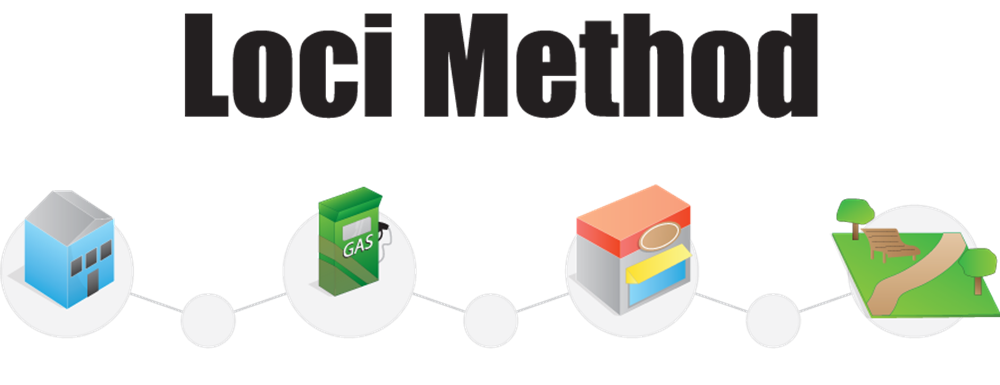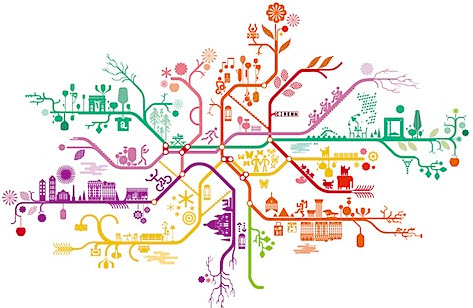
The method of loci is a method of memory enhancement where spatial memory and familiar information about one’s environment is utilized to quickly recall information. The method derives its name from the Latin word loci, which means spaces.
The memory journey method, the memory palace method, the mind palace method and the Roman room method can all be seen as variations of the method of loci.
Clemens Mayer from Germany, winner of the 2006 World Memory Championship, used the method of loci to memorise 1040 random digits in 30 minutes. Mayer used his own house as his “memory house” and created 300 individual memory points during his mental journey through the house.
Gary Shang, famous for having committed to memory 65,536 digits of pi, also uses the method of loci, as does eight-time World Memory Champion Dominic O’Brien.
For an individual with ordinary memorisation capabilities, it usually doesn’t require much practice to learn how to use the method of loci to successfully remember the sequence of the playing cards in a shuffled 52-card deck.
Origin
We know of the method of loci from ancient Greek and Roman rhetorical treatises, such as Cicero’s “De Oratore”, Quintillian’s “Instituto Oratoria” and the anonymous work “Rhetorica and Herenium”.
The basics
In their work “The Hippocampus as a Cognitive Map”1, John O’Keefe and Lynn Nadel describe the method of loci as follows:
“In this technique the subject memorizes the layout of some building, or the arrangement of shops on a street, or any geographical entity which is composed of a number of discrete loci. When desiring to remember a set of items the subject ‘walks’ through these loci in their imagination and commits an item to each one by forming an image between the item and any feature of that locus. Retrieval of items is achieved by ‘walking’ through the loci, allowing the latter to activate the desired items. The efficacy of this technique has been well established (Ross and Lawrence 1968, Crovitz 1969, 1971, Briggs, Hawkins and Crovitz 1970, Lea 1975), as is the minimal interference seen with its use.
How to use the method of loci
There are several approaches to the method of loci. Here are two examples:
- Define the key ideas of a subject. Link the key ideas. Deep-learn those key ideas in relation to each other.
- Define the key ideas of a subject. Think them through in depth. Re-arrange the ideas in relation to an argument. Link the ideas of loci in good order.
In the ancient text “Rhetorica and Herennium”, we learn to integrate the method of loci with elaborative encoding. This means that we add visual details, auditory details or similar in order to strengthen memory.
Some users of the method of loci like to create imaginary locations rather than use locations that they are familiar with from the world around them. They will for instance create imaginary houses, roads or towns.
Memory competitions
 Among successful participants in memory competitions, using the method of loci is very common. One of the most well-known contests is the World Memory Championship, where part of the competition consists of the participants having to remember and recall a sequence of digits, two-digit numbers, letters from the alphabet or playing cards. The method of loci is highly suited for remembering this type of data.
Among successful participants in memory competitions, using the method of loci is very common. One of the most well-known contests is the World Memory Championship, where part of the competition consists of the participants having to remember and recall a sequence of digits, two-digit numbers, letters from the alphabet or playing cards. The method of loci is highly suited for remembering this type of data.
A contestant using the method of loci will typically associate an image with the item, and then deposit the image at the locus. To recall all the items, the contestant will retrace the route and stop at each locus to “watch” the image at that particular locus and recall the item associated with it.
In Joshua Foer’s book “Moonwalking with Einstein”, World Memory Champion contestant Ed Cooke is quoted telling the author how outlandish and vulgar symbols are much easier to remember.
Your brain on loci
When we use the method of loci, regions of the brain associated with spatial awareness are activated. This has been confirmed by brain scanning. Examples of activated regions are the medial parietal cortex and the right posterior hippocampus.
The retrosplenial cortex is also activated when we use the method of loci, and Competitors in the World Memory Championships shows increased fMRI activation in their RSC compared to normal controls.
The retrosplenial cortex (RSC) is currently not well understood, but its location near visual areas and near the hippocampal spatial/memory system could mean that it plays a role in mediating between perceptual functions and memory functions. Individuals with lesions involving the RSC suffer from topographical disorientation and find it difficult to orient themselves even though they still have the ability to recognize and identify landmarks in the environment. RSC is also one of the first regions to develop pathological changes in an individual with Alzheimer’s disease.
In humans, the RSC only comprise 0.3% of he entire cortical surface. In rats, it is one of the largest cortial regions, extending for more than half of the cerebrum dorso-ventrally.
1O’Keefe, John; Nadel, Lynn (December 7, 1978). The Hippocampus as a Cognitive Map’. Oxford: Oxford University Press. ISBN 978-0198572060

